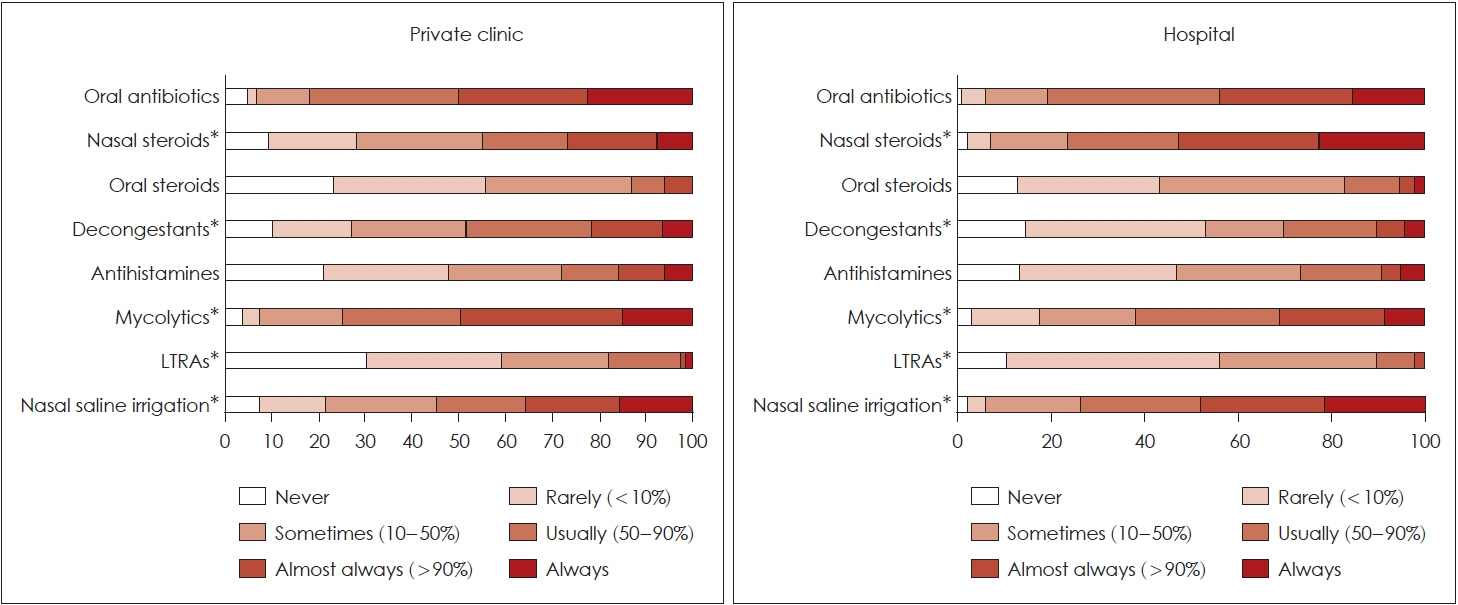J Rhinol.
2021 Mar;28(1):44-49. 10.18787/jr.2020.00343.
A Survey on the Management of Chronic Rhinosinusitis in the Korean Rhinologic Society
- Affiliations
-
- 1Department of Otorhinolaryngology-Head and Neck Surgery, Soonchunhyang University College of Medicine, Cheonan, Korea
- KMID: 2513842
- DOI: http://doi.org/10.18787/jr.2020.00343
Abstract
- Background and Objectives
There are several diagnostic and therapeutic modalities for chronic rhinosinusitis (CRS), but specific guidelines have not been developed for Koreans. This study sought to evaluate and report CRS practice patterns of members of the Korean Rhinologic Society. Materials and Method: An anonymous survey including 32 items was conducted from August to September 2015. The survey items were categorized into three parts: general information, diagnosis and treatment of CRS, and endoscopic sinus surgery.
Results
A total of 267 members participated in this survey. Almost half of the respondents (41.9%) were in their 40s and 42.7% had 10-20 years of experience. A total of 61.8% were private practitioners, while the rest worked in hospitals (38.2%). The prevalence rate of acute rhinosinusitis was higher in private clinics compared to hospitals (p<0.001). Intranasal steroids and saline irrigation were more commonly prescribed among hospital doctors compared to private practitioners (p<0.001). Amoxicillin/clavulanic acid was the drug of choice for adult and pediatric CRS patients among private practitioners. However, hospital doctors preferred macrolides for adult CRS patients and third-generation cephalosporins for pediatric CRS patients. Most private clinics performed surgery under local anesthesia (90.8%), while those in a hospital setting preferred general anesthesia (78.4%). Revision surgery rates were higher in hospitals compared to private clinics (p<0.001).
Conclusion
There were significant variations in CRS practice patterns between private clinics and hospitals. For effective and standardized diagnosis and management of CRS, appropriate local guidelines are needed.
Figure
Reference
-
References
1. Fokkens WJ, Lund VJ, Hopkins C, Hellings PW, Kern R, Reitsma S, et al. European Position Paper on Rhinosinusitis and Nasal Polyps 2020. Rhinology. 2020; 58:1–464.2. Orlandi RR, Kingdom TT, Hwang PH, Smith TL, Alt JA, Baroody FM, et al. International Consensus Statement on Allergy and Rhinology: Rhinosinusitis. Int Forum Allergy Rhinol. 2016; 6 Suppl 1:S22–209.3. Jung YG, Dhong HJ, Park YJ. Practice Patterns in Endoscopic Sinus Surgery: Survey of the Korean Rhinologic Society. J Rhinol. 2015; 22:82–8.4. Riley CA, Zheng Z, Williams N, Smith TL, Orlandi RR, Tabaee A. Concordance of self-reported practice patterns of American Rhinologic Society members with the International Consensus Statement of Allergy and Rhinology: Rhinosinusitis. Int Forum Allergy Rhinol. 2020; 10:665–72.5. Husain Q, Banks C, Bleier BS. Use of off-label steroid irrigations in chronic rhinosinusitis: a survey of the American Rhinologic Society. Int Forum Allergy Rhinol. 2020; 10:575–6.6. Smith EJ, Stringer S. Current perioperative practice patterns for minimizing surgical site infection during rhinologic procedures. Int Forum Allergy Rhinol. 2014; 4:1002–7.7. González-Castro J, Pascual J, Busquets J. National survey on the use of preoperative systemic steroids in endoscopic sinus surgery. Int Forum Allergy Rhinol. 2013; 3:497–503.8. Justice JM, Orlandi RR. An update on attitudes and use of imageguided surgery. Int Forum Allergy Rhinol. 2012; 2:155–9.9. Dubin MG, Liu C, Lin SY, Senior BA. American Rhinologic Society member survey on “maximal medical therapy” for chronic rhinosinusitis. Am J Rhinol. 2007; 21:483–8.10. Vennik J, Eyles C, Thomas M, Hopkins C, Little P, Blackshaw H, et al. Management strategies for chronic rhinosinusitis: a qualitative study of GP and ENT specialist views of current practice in the UK. BMJ Open. 2018; 8:e022643.11. Wang DY, Wardani RS, Singh K, Thanaviratananich S, Vicente G, Xu G, et al. A survey on the management of acute rhinosinusitis among Asian physicians. Rhinology. 2011; 49:264–71.12. Hoffmans R, Schermer T, van Weel C, Fokkens W. Management of rhinosinusitis in Dutch general practice. Prim Care Respir J. 2011; 20:64–70.13. Huang Z, Ma J, Sun Y, Zhou B. Maximal Medical Therapy for Chronic Rhinosinusitis: A Survey of Chinese Otolaryngologists. Ear Nose Throat J. 2020; 99:159–64.
- Full Text Links
- Actions
-
Cited
- CITED
-
- Close
- Share
- Similar articles
-
- Clinical Characteristics and Treatment of Fungal Rhinosinusitis
- Headache Characteristics in Rhinologic Patients and the Role of Surgical Treatment
- A Survey on Biologics for the Treatment of Chronic Rhinosinusitis With Nasal Polyps Among Members of the Korean Rhinologic Society
- Medical treatment according to phenotypes of chronic rhinosinusitis
- Headache and Facial Pain in Rhinologic Field : A 1 Year Experience


